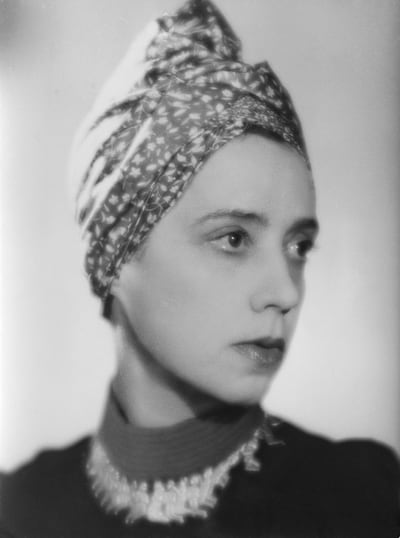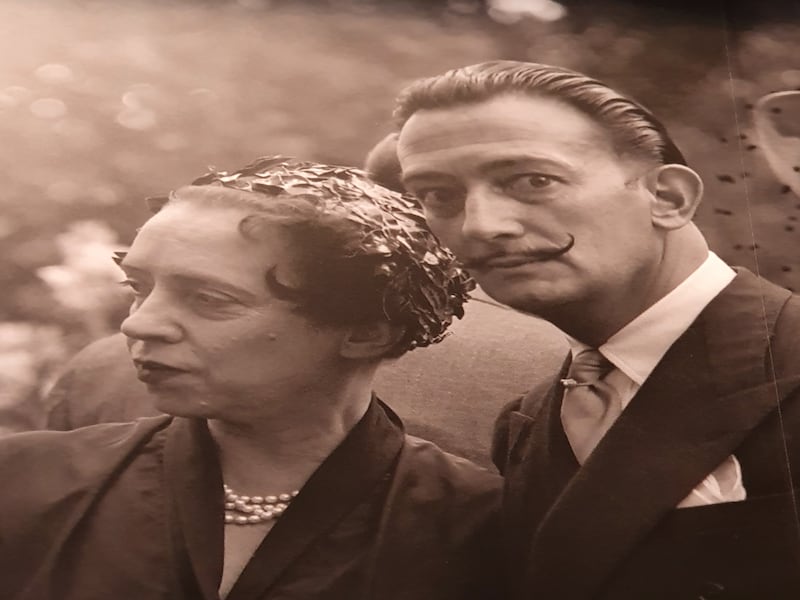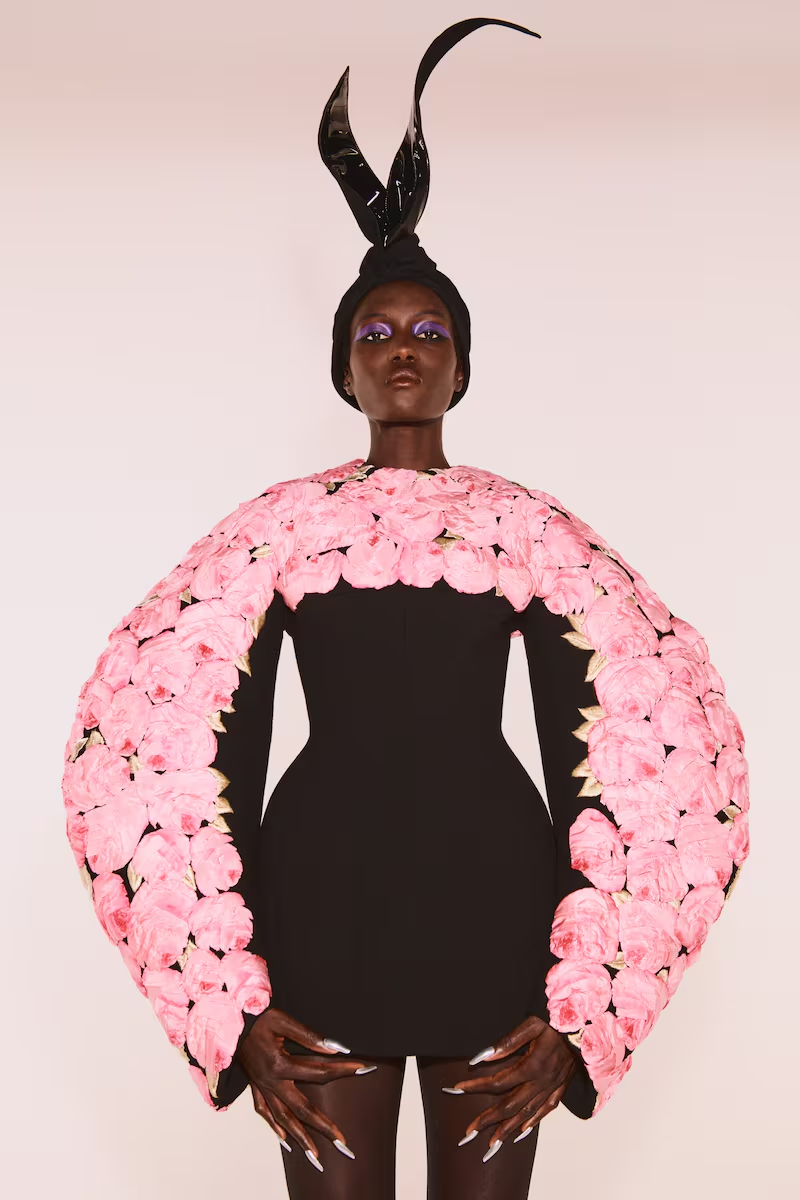She was best known for her signature shocking pink, “a brawling warrior pink” as St Laurent described it, but what was more shocking about Elsa Schiaparelli (1890-1973), a key figure in Paris between the two world wars, is her obscurity in today’s fashion world, according to US writer Judith Thurman. Compared with arch-rival Coco Chanel, who launched her house at the same time and will always be associated with the little black dress, Schiap (pronounced Skap), as she was known, is now almost forgotten.
This was the Italian designer who gave us the wrap dress long before Diane Von Furstenburg, the wedge shoe, transparent raincoats, the jumpsuit, culottes, the overall, colourful fun furs, halter necklines and knitwear – most famously the trompe-l’oeil sweater in 1927 that caused such a sensation.
This sweater and others like it are some of the first items on view at a major retrospective of the designer, Shocking: The surreal World of Elsa Schiaparelli, which is at the Musée des Arts Décoratifs, in Paris, until the end of this month. Way ahead of her time, Schiaparelli created the idea of pret-a-porter, who realised the potential of a ground floor shop where clients could walk in and buy off the peg, an idea that was revolutionary at the time.
This exhibition traces the development of her style and her artistic milieu in Paris, her imaginative creations taking their cue from surrealism, often making innovative use of new materials. She worked closely with artists including Man Ray, Jean Cocteau and Salvador Dalí, and her much photographed white evening gown modelled by Wallis Simpson in Vogue in 1937 was decorated with a lobster designed by Dalí. Her embroideries, exclusively made by Lesage, were masterpieces, and collaborations with Cocteau included a dress in silk jersey with two embroidered faces in profile creating the shape of a classic urn, and a linen evening jacket with an embroidered hand carrying a handkerchief in gilded metallic threads, tiny beads and paillettes.
Humour and irreverence were very much part of her style, and it was said that even at her peak in the 40s in the Place Vendôme in Paris, where she 350 seamstresses and young designers (including Hubert de Givenchy), she never took herself that seriously. “I like to amuse myself,” she once said. “If I didn’t I would die.” She will be remembered for her witty hats including one shaped like a shoe, another like a lamb cutlet. Visitors to the exhibition crowd around such accessories – the gloves dramatised with red fingernails or decorated with butterflies, and the jewellery including golden masks, the “aspirin” necklace, and buttons in the shapes of birds, acrobats or elephants.
[ Hubert de Givenchy obituary: couturier to Audrey Hepburn and Jackie KennedyOpens in new window ]
Her collections had titles like Pagan, Music, Circus. Her last was called Commedia dell’Arte, a riotously colourful affair with shocking pink hosiery and tutu skirts, and featured a wool harlequin coat that stole the show. She was the designer to be seen in from 1935 to 1939, but the outbreak of war changed everything and as the influence of surrealism faded, Schiaparelli’s bolder fantasies did not correspond to the postwar mood and sales of her best selling perfume Shocking (whose bottle shape was modelled on Mae West’s silhouette) also suffered. Dior was to steal the headlines with his New Look in 1947, and she eventually ended her design career in 1954.

Since its revival in 2007 when bought by Tods owner Diego della Valle, the Maison has been helmed by various creative directors and restored to its premises in Place Vendôme in Paris, but it was the appointment of Texan designer Daniel Rosebery in 2019 that has propelled the name into the spotlight again, most notably with the ensemble in navy and red worn by Lady Gaga at Joe Biden’s inauguration in January 2021.
Since then his reputation has snowballed. He has dressed Beyoncé in a leather mini for the Grammys, Bella Hadid at Cannes in a black dress with a lung-shaped gold breastplate, and Jessie Buckley in a boyish grey suit for the Met Gala. Some of his red carpet creations are included in the exhibition, which brings together 520 works including 272 silhouettes and accessories by Schiaparelli, displayed alongside paintings, sculptures, jewellery, perfumes, ceramics, posters and photographs spread over two floors.

Her legacy lives on through her huge influence on Miucca Prada, following Schiaparelli & Prada: Impossible Conversations, a major exhibition in the Costume Institute in New York in 2012 exploring the affinities between the two designers. The Museum of Philadelphia has an extensive collection of garments by Schiaparelli including 71 original models donated by the designer in 1969, many of which are iconic works.

Schiaparelli was a fan of Irish tweed and used it extensively in her collections in the 1930s. She was the first purchaser of the Avoca thistledown tweed when it was originally made by the Wynne sisters in Avoca. She used it for years in her collections, having the monopoly of certain colours and designs. She also made a visit to Ireland in 1953 as a judge of a clothing competition for the An Tóstal festival, and was filmed by Pathé News with Phyllis Ryan, wife of the then president of Ireland Seán T O’Kelly, at the fashion show in the Gresham Hotel in which all the items were made of Irish linen and tweed.
Shocking! The Surreal World of Elsa Schiaparelli runs at the Musée des Arts Décoratifs in Paris until January 22nd
Books on Schiaparelli include her autobiography Shocking Life published by Dent in 1954 and reprinted by the V & A in 2007; Elsa Schiaparelli, a biography by Meryle Secrest (Penguin, 2014); Schiaparelli & Prada Impossible Conversations (Met New York, 2012); The Little Book of Schiaparelli by Emma Baxter Wright (Welbeck, 2012).




















